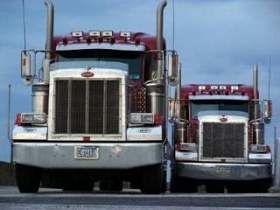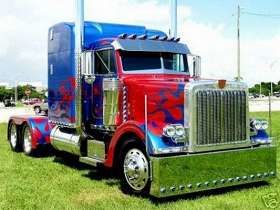New! High Road 2.0! We have a new version of this program. You can find it here: High Road 2.0
2.14 Seeing Hazards
A hazard is any road condition or other road user (driver, bicyclist, pedestrian) that is a possible danger. For example, a car in front of you is headed toward the freeway exit, but the carʼs brake lights come on and the driver begins braking hard. This could mean that the driver is uncertain about taking the offramp. He/she might suddenly return to the highway. This car is a hazard. If the driver of the car cuts in front of you, it is no longer just a hazard; it is an emergency.
Seeing Hazards Lets You Be Prepared

You will have more time to act if you see hazards before they become emergencies. In the example above, you might make a lane change or slow down to prevent an accident if the car suddenly cuts in front of you. Seeing this hazard gives you time to check your mirrors and signal a lane change. Being prepared reduces the danger. A driver who did not see the hazard until the slow car pulled back on the highway in front of him/her would have to do something very suddenly. Sudden braking or a quick lane change is much more likely to lead to an accident.
There are often clues that will help you see hazards. The more you drive, the better you get at spotting hazards. Slow down and be very careful if you see any of the following road hazards:
- Work zones: When people are working on the road it is a hazard. There may be narrower lanes, sharp turns or uneven surfaces. Other drivers are often distracted and drive unsafely. Workers and construction vehicles may get in the way. Drive slowly and carefully near work zones. Use your four-way flashers or brake lights to warn drivers behind you.
- Drop-offs: Sometimes the pavement drops off sharply near the edge of the road. Driving too close to the edge can tilt your vehicle toward the side of the road. This can cause the top of your vehicle to hit roadside objects (signs, tree limbs, etc.). It also can be hard to steer as you cross the drop-off, whether going off the road or coming back on.
- Foreign objects: Things that have fallen on the road can be hazards. They can be a danger to your tires and wheel rims, damage electrical and brake lines, or become caught between dual tires and cause severe damage. Some obstacles that can appear to be harmless can be very dangerous. For example, cardboard boxes may be empty, but they also may contain solid or heavy material capable of causing damage. The same is true of paper and cloth sacks. Remain alert for objects of all sorts, so you avoid them without making sudden, unsafe moves.
- Offramps/onramps: Freeway and turnpike exits can be particularly dangerous for commercial vehicles. Offramps and onramps often have speed limit signs posted. Remember, these speeds may be safe for automobiles but may not be safe for larger vehicles or heavily loaded vehicles. Exits that go downhill and turn at the same time can be especially dangerous. The downgrade makes it difficult to reduce speed. Braking and turning at the same time can be a dangerous practice. Make sure you are going slow enough before you get on the curved part of an offramp or onramp.
Hazardous Drivers, Vehicles and Pedestrians
To protect yourself and others, you must know when other drivers may do something hazardous. Some clues to these types of hazards include:
- People who cannot see others - Be alert for drivers whose vision is blocked. Vans, loaded station wagons and cars with the rear window blocked are examples.
- Rental trucks - Drivers often are not used to the limited vision they have to the sides and rear of the truck.
- Vehicles with frosted, ice-covered or snow-covered windows.
- Partially hidden vehicles - Vehicles may be partly hidden by blind intersections or alleys. If you can see only the rear or front end of a vehicle but not the driver, then he/she cannot see you. Be alert because he/she may back out or enter into your lane. Always be prepared to stop.
- Delivery trucks - The driverʼs vision often is blocked by packages or vehicle doors. Drivers of step vans, postal vehicles and local delivery vehicles often are in a hurry and may suddenly step out of their vehicle or drive into the traffic lane.
- Parked vehicles - Parked vehicles can become hazards when passengers start to get out. Or they may suddenly start up and drive into your path. Watch for movement inside the vehicle or movement of the vehicle itself that shows people are inside. Watch for brake lights or backup lights, exhaust and other clues that a driver is about to move.
- Stopped buses - Passengers may cross in front of or behind the bus, and they often cannot see you.
- Pedestrians and bicyclists - Walkers, joggers and bicyclists may be on the road with their backs to the traffic, so they cannot see you. They also may be wearing electronic devices so they cannot hear you either. On rainy days, pedestrians may not see you because of hats or umbrellas. They may be hurrying to get out of the rain and may not pay attention to the traffic.
- People who are distracted - Watch for where they are looking. If they are looking elsewhere, they cannot see you. But be alert even when they are looking at you; they may think they have the right-of-way.
- Children - Children tend to act quickly without checking traffic. Children playing with one another may not look for traffic and are a serious hazard.
- Talkers - Drivers or pedestrians talking to one another may not be paying close attention to the traffic.
- Workers - People working on or near the roadway creates a distraction for other drivers, and the workers themselves may not see you.
- Ice cream trucks - Children may be nearby and may not see you.
- Disabled vehicles - Drivers changing a tire or fixing an engine often do not pay attention to the dangers of roadway traffic. They often are careless. Jacked-up wheels or raised hoods are hazard clues.
- Accidents - People involved in the accident may not look for traffic. Passing drivers tend to look at the accident. People often run across the road without looking. Vehicles may slow down or stop suddenly.
- Shoppers - People in and around shopping areas often are not watching traffic because they are looking for stores or looking into store windows.
- Turning vehicles - Drivers signaling a turn may be a hazard. Drivers signaling a turn may slow more than expected or stop. If they are making a tight turn into an alley or driveway, they may go very slow. If they are blocked by pedestrians or other vehicles, they may have to stop on the roadway. Vehicles turning left may have to stop for oncoming vehicles.
- Confused drivers - Confused drivers often change direction suddenly or stop without warning. Confusion is common near freeway or turnpike interchanges and major intersections. Tourists unfamiliar with the area can be very hazardous. Clues to tourists include car-top luggage and out-of-state license plates. Unexpected actions (stopping in the middle of a block, changing lanes for no apparent reason, back-up lights suddenly going on) are clues to confusion. Hesitation is another clue, including driving very slowly, using brakes often or stopping in the middle of an intersection. You also may see drivers looking at street signs, maps and house numbers. These drivers may not be paying attention to you.
- Slow drivers - Motorists who fail to maintain normal speed are hazards. Seeing slow-moving vehicles early can prevent a crash. Some vehicles, by their nature, are slow and seeing them is a hazard clue (mopeds, farm implements, construction machinery, tractors, etc.). Some will have the Slow-Moving Vehicle symbol to warn you. Watch for a red triangle with an orange center.
- Drivers in a hurry - Drivers may feel your commercial vehicle is preventing them from getting where they want to go on time. Such drivers may pass you without a safe gap in the oncoming traffic, cutting too close in front of you. Drivers entering the road may pull in front of you to avoid being stuck behind you, causing you to brake. Be aware of this and watch for drivers who are in a hurry.
- Impaired drivers - Drivers who are sleepy, have had too much to drink, are on drugs, or are ill are hazards. Some clues to these drivers include:
- Weaving across the road or drifting from one side to another.
- Leaving the road (dropping right wheels onto the shoulder, or bumping across a curb in a turn).
- Stopping at the wrong time (stopping at a green light, or waiting too long at a stop).
- Open window in cold weather.
- Speeding up or slowing down suddenly, driving too fast or too slow.
- Be alert for drunk drivers and sleepy drivers late at night.
Driver Body Movement as a Clue
Drivers look in the direction they are going to turn. You may sometimes get a clue from a driverʼs head and body movements that a driver may be going to make a turn even though the turn signals are not on. Drivers making over-the-shoulder checks may be going to change lanes. These clues are most easily seen in motorcyclists and bicyclists. Watch other road users, and try to tell whether they might do something hazardous.
Conflicts

You are in conflict when you have to change speed and/or direction to avoid hitting someone . Conflicts occur at intersections where vehicles meet, at merges (such as turnpike on ramps) and where there are needed lane changes (such as the end of a lane, forcing a move to another lane of traffic). Other situations include slow-moving or stalled traffic in a traffic lane, and accident scenes. Watch for other drivers who are in conflict because they are a hazard to you. When they react to this conflict, they may do something that will put them in conflict with you.
You should always be looking for hazards. Continue to learn to see hazards on the road. However, do not forget why you are looking for the hazards - they may turn into emergencies. You look for hazards in order to have time to plan a way out of any emergency. When you see a hazard, think about the emergencies that could develop and figure out what you would do. Always be prepared to take action based on your plans. This way, you will be a prepared, defensive driver who will improve not only your own safety but the safety of everyone on the road.
Suggested speed limit signs are not designed for trucks. As a general rule of thumb, truckers take curves at 10mph under the posted speed. But at times, this may be too fast as well. It's always better to enter a turn too slow rather than too quickly.
Know the meaning and have a general understanding of what a roadway conflict is.










 TT On Facebook
TT On Facebook